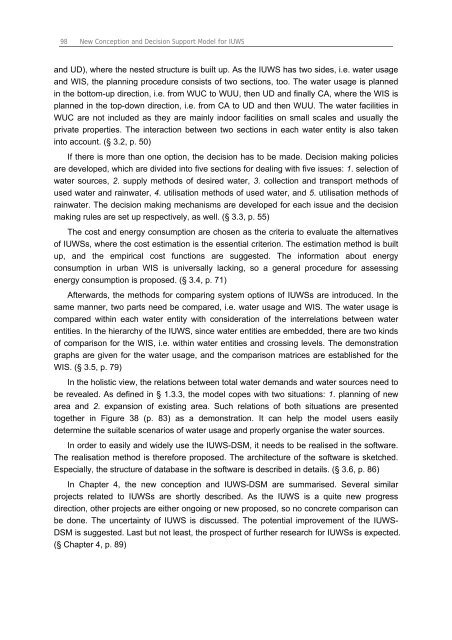Chapter 3 Decision Support Model (IUWS-DSM) - Tubdok
Chapter 3 Decision Support Model (IUWS-DSM) - Tubdok
Chapter 3 Decision Support Model (IUWS-DSM) - Tubdok
You also want an ePaper? Increase the reach of your titles
YUMPU automatically turns print PDFs into web optimized ePapers that Google loves.
98 New Conception and <strong>Decision</strong> <strong>Support</strong> <strong>Model</strong> for <strong>IUWS</strong><br />
and UD), where the nested structure is built up. As the <strong>IUWS</strong> has two sides, i.e. water usage<br />
and WIS, the planning procedure consists of two sections, too. The water usage is planned<br />
in the bottom-up direction, i.e. from WUC to WUU, then UD and finally CA, where the WIS is<br />
planned in the top-down direction, i.e. from CA to UD and then WUU. The water facilities in<br />
WUC are not included as they are mainly indoor facilities on small scales and usually the<br />
private properties. The interaction between two sections in each water entity is also taken<br />
into account. (§ 3.2, p. 50)<br />
If there is more than one option, the decision has to be made. <strong>Decision</strong> making policies<br />
are developed, which are divided into five sections for dealing with five issues: 1. selection of<br />
water sources, 2. supply methods of desired water, 3. collection and transport methods of<br />
used water and rainwater, 4. utilisation methods of used water, and 5. utilisation methods of<br />
rainwater. The decision making mechanisms are developed for each issue and the decision<br />
making rules are set up respectively, as well. (§ 3.3, p. 55)<br />
The cost and energy consumption are chosen as the criteria to evaluate the alternatives<br />
of <strong>IUWS</strong>s, where the cost estimation is the essential criterion. The estimation method is built<br />
up, and the empirical cost functions are suggested. The information about energy<br />
consumption in urban WIS is universally lacking, so a general procedure for assessing<br />
energy consumption is proposed. (§ 3.4, p. 71)<br />
Afterwards, the methods for comparing system options of <strong>IUWS</strong>s are introduced. In the<br />
same manner, two parts need be compared, i.e. water usage and WIS. The water usage is<br />
compared within each water entity with consideration of the interrelations between water<br />
entities. In the hierarchy of the <strong>IUWS</strong>, since water entities are embedded, there are two kinds<br />
of comparison for the WIS, i.e. within water entities and crossing levels. The demonstration<br />
graphs are given for the water usage, and the comparison matrices are established for the<br />
WIS. (§ 3.5, p. 79)<br />
In the holistic view, the relations between total water demands and water sources need to<br />
be revealed. As defined in § 1.3.3, the model copes with two situations: 1. planning of new<br />
area and 2. expansion of existing area. Such relations of both situations are presented<br />
together in Figure 38 (p. 83) as a demonstration. It can help the model users easily<br />
determine the suitable scenarios of water usage and properly organise the water sources.<br />
In order to easily and widely use the <strong>IUWS</strong>-<strong>DSM</strong>, it needs to be realised in the software.<br />
The realisation method is therefore proposed. The architecture of the software is sketched.<br />
Especially, the structure of database in the software is described in details. (§ 3.6, p. 86)<br />
In <strong>Chapter</strong> 4, the new conception and <strong>IUWS</strong>-<strong>DSM</strong> are summarised. Several similar<br />
projects related to <strong>IUWS</strong>s are shortly described. As the <strong>IUWS</strong> is a quite new progress<br />
direction, other projects are either ongoing or new proposed, so no concrete comparison can<br />
be done. The uncertainty of <strong>IUWS</strong> is discussed. The potential improvement of the <strong>IUWS</strong>-<br />
<strong>DSM</strong> is suggested. Last but not least, the prospect of further research for <strong>IUWS</strong>s is expected.<br />
(§ <strong>Chapter</strong> 4, p. 89)

















